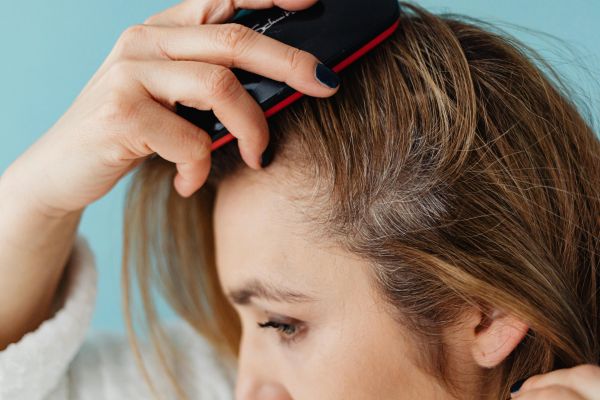Simple lifestyle changes will promote hair growth

 Hair loss is most commonly caused by genetics, lifestyle, diet, stress, environmental damage and hormonal changes, among others. It becomes more common in men and women with age. Most healthy people lose between 50 and 100 single hairs per day. When you start to shed more strands — and fewer or none grow back — the condition is considered alopecia (hair loss).
Hair loss is most commonly caused by genetics, lifestyle, diet, stress, environmental damage and hormonal changes, among others. It becomes more common in men and women with age. Most healthy people lose between 50 and 100 single hairs per day. When you start to shed more strands — and fewer or none grow back — the condition is considered alopecia (hair loss).
Every strand of hair on your head has a lifespan between 3 and 5 years. Hair shedding is part of a natural balance — some hairs fall out while others grow in. Hair loss occurs when your hair’s growth cycle is disrupted. This can cause shedding, bald spots and thinning hair.
Like most other things in life, we only think of treating this problem when it’s out of control, rather than preventing the issue before it becomes too serious.
However, unless the cause is medical or genetic, managing hair fall is simply a matter of following healthy habits. Some are as simple as eating a healthy diet, managing stress levels and blow drying less.
A healthy diet can help your hair stay strong and shiny. What you eat can also keep you from losing your locks. If you’re not getting certain nutrients from food, you might see the effects in your hair.
On that note, here are easy-to-do, practical steps all women can follow to manage their hair health and prevent hair thinning. Take a look!
Take care of your nutrition: Your hair reflects your overall health. A balanced diet is the first step to healthier hair. If you’re not getting enough nutrients, your hair will show it.
Your strands need all types of nutrients to grow thick and strong. While vitamins don’t necessarily promote hair growth, some mineral and vitamin deficiencies can cause hair loss. Include iron-rich foods like spinach and lentils to prevent hair thinning. Biotin sources, like eggs and nuts, for stronger strands.
Include fish, dairy, eggs, beans, lentils, nuts and seeds to avoid hair thinning.
Vitamin B12, folic acid and biotin are types of Vitamin B associated with good hair. These are essential in maintaining healthy follicles, which help in hair growth and decrease shedding. Trace minerals like iron, magnesium, zinc and biotin also affect hair, and it is a good idea to take a daily multivitamin.
Hydrating fluids like coconut water nourish your hair from within
Quit smoking: Smoking affects the hair follicles in multiple ways. If you are exposed to cigarette smoke, unsafe chemicals can settle on your hair and scalp. These chemicals can damage the hair shaft by making your hair dry and more prone to breakage.
Smoking is a serious factor in the development of androgenetic alopecia. It is a common type of hair loss in both men and women (also known as pattern baldness). Smoking can trigger inflammation in the scalp, which can damage hair follicles and further contribute to the problem of hair loss.
Nicotine and other injurious substances in cigarettes can induce vasoconstriction. It narrows your blood vessels, which can reduce blood flow. This impacts the blood supply to your scalp and eliminates the vital nutrients and oxygen to your hair follicles.
When a person quits smoking, it is possible to undo some of the damage caused by the harmful effects of smoking, but the same cannot be said for those who have developed male pattern baldness. If smoking has caused androgenetic alopecia, then it can only be slowed down with dermatological treatments.
Use a derma roller: This simple tool is gaining fame for its ability to boost hair growth, tackle hair thinning, or give hair a little extra oomph. It’s considered a minimally invasive procedure with a fairly speedy recovery time, especially with shorter needles.
When you roll this small gadget featuring a roller covered in fine needles over your scalp, these needles create tiny pinpricks in the skin, increasing blood circulation in the scalp. More blood means more nutrients and oxygen, which are like superfoods for your hair follicles.
This increased blood flow can wake up dormant hair follicles, giving them the nudge they need to start growing hair again.
Over time, the improved scalp health and increased nutrient delivery can lead to thicker, fuller hair. It’s like giving your hair a natural volume boost from within.
If you are new to derma rolling, begin with a 10-minute home session once a week and gradually increase the frequency if your skin tolerates it well.
Detangle hair: Irrespective of long, luscious locks or short hair, a hair knot mess is experienced by almost everyone.
It is not an easy task to remove a hair knot without destroying your hair. But it is not impossible either. Some tips about detangling include brushing your hair before washing if you have hair that gets tangled easily, and using a small amount of shampoo on the strands when compared to the scalp.
Get your hair trimmed every 4-6 weeks. Split ends cause tangles, making your hair look damaged and dry. Apply conditioner and comb your hair to detangle and spread out the conditioner evenly. But be gentle because wet hair is more prone to shedding. Hair knots are often difficult to detangle. But products like hair oil, hair mask or even hair conditioner can make it easier to remove the knots.
It is especially important to detangle curly hair. The tight curls and coils can easily become intertwined, making it essential to detangle to prevent breakage. By detangling your hair before washing or styling, you can ensure that your curls stay intact and undamaged.
Banner image by Kaboompics.com: https://www.pexels.com/photo/a-close-up-shot-of-a-woman-brushing-her-hair-7320791/




